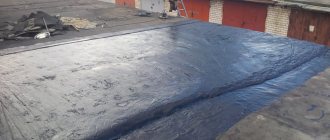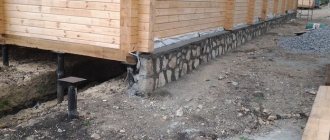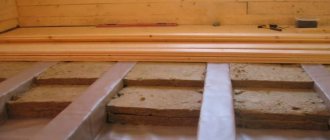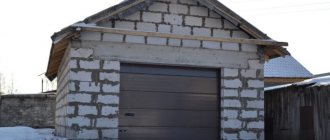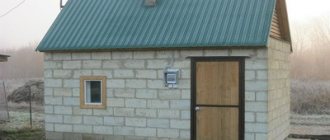Basic requirements for insulation coating
Cars do not tolerate prolonged exposure to moisture well. Because of this, the metal (mainly the body) becomes corroded. If the car is stored in an unheated garage, insulation under the roof will be required to prevent condensation.
Insulation materials used for these purposes must meet the following requirements:
- increased resistance to flame;
- should not absorb vapors emitted by chemicals (car oils, gasoline, etc.);
- are not able to accumulate moisture;
- light weight;
- long service life;
- resistant to mold and fungi.
The roofing material should provide comfortable conditions inside the garage throughout the year, regardless of the temperature and humidity level of the environment.
The thermal insulation layer should not attract rodents. These requirements are met by several materials that can be used to insulate the roof in a garage.
How to insulate a garage roof
Before you take off and start spontaneously insulating your garage, it is worth studying the structural features and specifics of operation.
First, decide on the garage heating mode:
- Constantly heated.
- Heated periodically (only in very cold weather).
- Not heated at all.
Having determined the approximate temperature limits in which the insulation will work, pay attention to the humidity of the room. Here it is worth considering that in addition to ordinary steam, vapors of fuels and lubricants, as well as diesel fuel, gasoline and other flammable liquids will necessarily be formed.
Taking into account the above, the most suitable materials for insulating a garage are:
- Polystyrene foam and other polymer insulation materials.
- Fiberglass.
- Mineral wool.
Polystyrene foam is a modern building material. It is widely used in thermal insulation of buildings. Its operational features allow it to be used both in internal and external work. Due to its wide range of applications, foam plastic is in constant demand in all construction companies.
Fiberglass is a thread obtained from glass production waste. Unlike glass, it can bend in any direction without breaking. It has elasticity and does not burn. Capable of operating in a wide temperature range.
Mineral wool, in addition to thermal insulation, has a soundproofing effect. However, its use in wet areas without appropriate protection is impractical.
Choosing the best option
There are several solutions to the question of how to insulate a garage roof. For these purposes, you can use various thermal insulation materials that differ in cost, performance and a number of other characteristics. The correct and inexpensive solution is to lay sheets of polystyrene foam under the roof of the garage. But, if you wish and have a sufficient budget, you can purchase other insulation materials.
Styrofoam
Polystyrene foam is an inexpensive and practical solution to the problem. Expanded polystyrene sheets are inexpensive and help insulate the roof and other structural elements of the garage. Polyfoam has the following features:
- fragile;
- does not absorb moisture;
- does not allow heat to pass out;
- light weight.
Polyfoam is easy to install and prevents the formation of condensation inside the garage. The main disadvantage of such thermal insulation is that insects and rodents often find refuge under the sheets. The latter violate the integrity of the foam, which is why “bridges” of cold appear. The insulation is also susceptible to burning.
Penoplex can eliminate the described disadvantages. The only disadvantage of this insulating coating is that the price of one sheet is higher than that of polystyrene foam.
Glass wool
This insulating coating is made of fiberglass, which undergoes heat treatment. Glass wool is practically not used for laying a thermal insulation layer along the roof of a garage. However, insulation has several advantages:
- withstands moisture;
- does not attract rodents;
- not susceptible to fungus formation;
- provides good thermal insulation.
The low popularity of glass wool is explained by the fact that the insulation, under the influence of minor loads, loses its original properties. In addition, when working with insulating coating, it is necessary to take precautions (wear a respirator, gloves and protective clothing).
Penoizol
Liquid insulation is easy to use, therefore, provided you have enough budget, it is suitable for laying along the roof of the garage. Penoizol is sprayed along the inside of the roof and closes any small holes. The disadvantages of penoizol include high cost and the need to use additional equipment.
Minvata
In appearance it resembles glass wool, but the mineral composition (basalt) provides better characteristics. Mineral wool is produced in the form of rolls, does not attract rodents and does not burn. The operational life of the heat insulator is 50 years. The main disadvantage of mineral wool is the need to lay a vapor barrier layer, since the insulation absorbs moisture in small quantities.
Polymers
Polymers are produced in the form of plates and have the following advantages:
- relatively low price;
- low thermal conductivity;
- simple installation;
- light weight;
- resistance to open flame (typical of new polymers).
Polymers do not require laying a vapor barrier layer, but do not tolerate exposure to direct sunlight.
We insulate the gate - the car should not freeze
Metal garage doors without insulation are the main source of cold and dampness in the garage. It is necessary to insulate the gate. You can choose several options for thermal insulation of garage doors:
- laying insulation over metal sheathing, similar to wall insulation;
- installation of foam plastic directly to the door leaf using liquid nails;
- you can use quick and reliable insulation with polyurethane foam;
- reliable thermal insulation with sprayed polyurethane foam.
Any technology for insulating metal gates requires compliance with basic rules:
you need to clean the surface from dirt, rust and remnants of the old coating; it is important to degrease the metal surface; be sure to treat the metal with a rust-preventing primer, and the wood with an antiseptic against mold and drying oil; all cracks around the perimeter of the box are sealed with polyurethane foam and cemented; no voids should be left when laying the insulation layer; foil heat-reflecting coating reduces heat loss by 15 percent.
It is necessary to install seals on the gate leaves, since there is considerable heat loss through the cracks.
Thermal insulation methods
It is recommended to select methods for laying a thermal insulation layer under the roof before installing the rafter structure. This will save time and select the appropriate insulation. There are two ways to install thermal insulation on a garage roof: from the outside and from the inside. Each of these approaches has advantages and disadvantages.
From the inside
Insulation from the inside is carried out in cases where the roof is made of beam structures or reinforced concrete slabs. This option involves laying three layers in the room: steam, heat and waterproofing. If the roof has a beam structure, before installing the specified materials, the roof is sheathed with sheets of insulation. In cases where the roof is made of reinforced concrete slabs, a frame for thermal insulation is first installed on the latter.
Outside
External insulation is carried out after installing the rafter structure, but before laying the roof. The installation process is not much different from the previous one. The only difference is that reinforced concrete slabs cannot be insulated from the outside.
Requirements for protecting a garage from low temperature
Garages are primarily built from cinder block, brick, and sometimes ironwork. The thickness of walls made of cinder block or brick is most often in the range of 120-250 mm. They practically do not protect the room from low temperatures, so for comfortable work they need to be reliably insulated.
When insulating a garage internally, you do not need to seal all the holes - this will not improve thermal insulation, but can cause certain problems. Without constant ventilation, moisture from the air will condense on the metal and it will begin to rust. Ventilation also prevents harmful gases from accumulating in the garage.
What tools and materials will be needed?
The type of tools used to insulate the garage roof is selected taking into account the purchased materials. Together with mineral wool you need to prepare:
- slats or metal profiles for attaching mineral wool;
- vapor barrier;
- scotch;
- polyurethane foam and gun;
- hacksaw for metal;
- construction stapler.
In the case of foam plastic you will need:
- polyurethane foam with a gun;
- stationery knife;
- self-tapping screws;
- screwdriver
If polymers are used, a special sprayer will be required. Also, regardless of the type of materials, it is recommended to take a level.
Microclimate for a car in the cold season
Only with the sharp approach of cold weather do car owners begin to remember the need to insulate the garage. Whatever material the walls and ceiling are built from, without an insulating layer they very quickly begin to let cold and moisture into the room, which has an extremely negative impact on the car’s storage conditions.
What conditions are considered optimal to ensure that your vehicle does not cause trouble? The average temperature during the winter should be about +5°C, and the flow of fresh air should be 150-180 m³/h, depending on the size of the garage. Such parameters require careful planning of insulation measures, because if you overdo it and install too thick a layer of insulation, “greenhouse” conditions may arise in the garage. This threatens the appearance of condensation on the car body after driving indoors from the street, which accelerates the development of rust and shortens the period of operation of the car.
Properly organized ventilation also helps create the necessary microclimate for the car. Under no circumstances should heat loss be reduced by closing the ventilation - this will lead to stagnation of air saturated with moisture and vapors of flammable substances. It must be remembered that the main enemy of a car is not the cold itself, but its combination with moisture. By removing humid air from the room, preventing rain and snow from seeping through the roof, you will create ideal storage conditions for your vehicle.
The choice of whether to insulate the garage roof from the outside or from the inside depends on the specific situation. Internal insulation is most conveniently done for sloping or flat roofs.
Garage roof insulation technology
The algorithm for carrying out construction work with your own hands depends on the type of garage roof and the materials used. It must be remembered that in some cases installation of vapor and waterproofing will be required.
Wooden
You can begin laying insulation on a wooden garage roof immediately after completing the installation of the rafter structure. At the first stage, it is necessary to sew up the beams with sheet material, after which you can begin the rest of the work.
Installation of foam plastic and mineral wool takes place in several stages:
- a waterproofing layer is fixed between the rafters of the garage roof with a slight sag;
- sheets of thermal insulation are laid between the rafters and fixed with strips or lathing;
- the joints are filled with sealant (spray foam);
- A vapor barrier membrane is laid along the foam (mineral wool), which is fixed with adhesive tape.
Upon completion of the work, the thermal insulation boards are covered with chipboard, plasterboard or other “rough” material. After this, you can begin finishing the interior of the garage roof.
If the insulation is installed outside, the order of work is as follows:
- a vapor barrier membrane is fixed between the rafters using brackets so that the material sag;
- the sheathing is installed and mineral wool is laid;
- joints are sealed;
- The waterproofing film is laid and the roofing material is installed.
In cases where penoizol is used, it is enough to spray the material between the beams using the appropriate tool. There is no need to lay additional insulating layers.
Concrete
Laying thermal insulation on a concrete surface is carried out according to a similar algorithm as described above. The only exception is that in this case, a frame (metal is recommended) is first installed, intended for attaching the insulation.
How to insulate a concrete roof of a garage or house
Externally, you can use polystyrene foam and mineral wool slabs of increased rigidity, for example, Tekhnoruf from the well-known company TechnoNIKOL. External insulation of a concrete roof is preferable when the ceiling has been finished inside the room and additional costs will be required for dismantling and installing the finishing. In addition, high-quality waterproofing of the insulation will be required, since it will be exposed to moisture all year round.
Photo. Scheme for laying mineral wool slabs on a flat roof
If waterproofing is properly installed on the outside, then work can be done from the inside. In this case, you can use cheaper mineral wool with a lower density, as well as foam boards. Please note that carrying out work inside is accompanied by a loss of some ceiling height in the room. And mineral wool needs to be additionally protected with a vapor barrier membrane from moisture contained in the air.
Features of the work
When laying insulation on the roof of a garage, it is necessary to take into account the design features. There are two roofing options: single- and gable. The requirements for the type of material and the procedure for installing the heat-insulating layer are the same in both cases. However, due to the design features of the roof, some problems may arise during the work.
Shed roof
This type of roof has a simple design, which is why it is often used in the construction of a garage. If the latter is adjacent to a house or other building, when laying insulation, it is important to eliminate the gaps between the material and the neighboring building. Otherwise, “bridges” of cold will form in this zone.
If a garage with a pitched roof stands separately from other structures, then the installation of thermal insulation is carried out according to the described algorithm. It is important to ensure that the materials on both sides of the roof are tightly covered with a canopy.
Gable
When installing a vapor barrier on single- and gable roofs, it is necessary to leave a ventilation gap. To do this, it is enough to place bars in several places between the material and the sheets with which the beams are sheathed.
When working on a gable roof, problems may arise when insulating the junction of the beams at the top point. This point requires special attention. To avoid the formation of cold bridges, it is important to foam all the cracks on the ridge.
Insulation materials: why are they needed and what are they?
So, we have already figured out why we need to insulate the garage. Now you need to understand in detail what to insulate it with and what properties are required for insulation. It so happened that the insulation materials needed for a garage roof are not quite similar to those used to cover ordinary houses. This difference occurs due to the fact that many different paints, varnishes and other substances can be found and used in the garage, which can be chemically hazardous and should not be inhaled. If the roof insulation absorbs these vapors and fumes, it can later become a source of serious health problems. That is why the choice of insulation for a garage must be taken seriously. The top sellers are glass wool and polystyrene foam.

